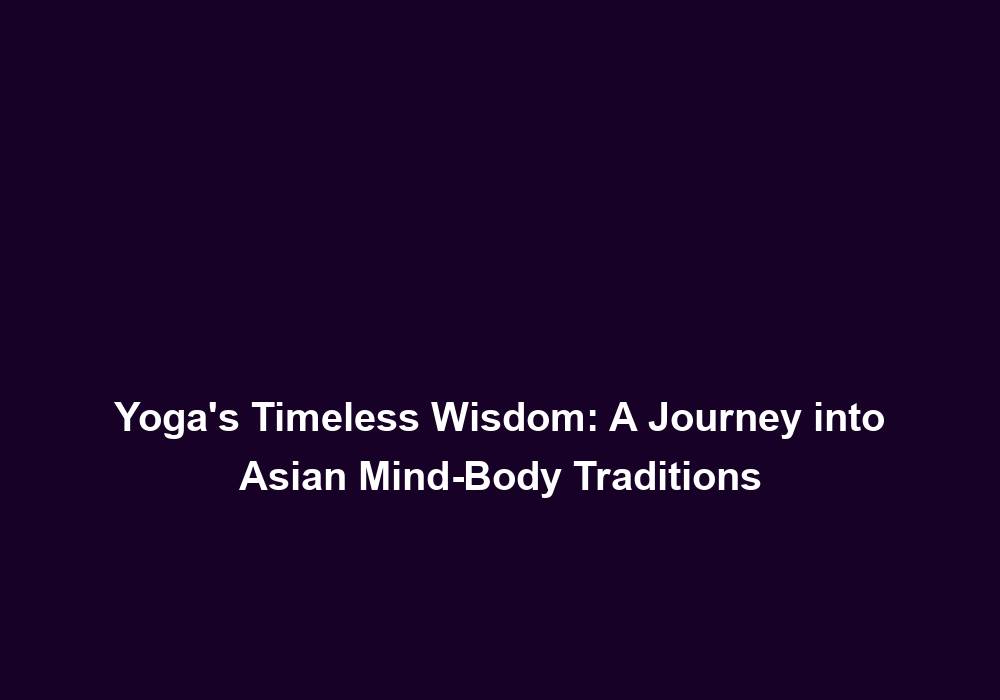Yoga’s Timeless Wisdom: A Journey into Asian Mind-Body Traditions
Yoga is more than just a physical exercise; it is a journey into the depths of Asian mind-body traditions that have been passed down through generations. The timeless wisdom embedded in yoga offers profound insights into holistic well-being, self-discovery, and spiritual enlightenment. In this article, we will delve into the rich tapestry of yoga and explore its origins, benefits, and practices.
Understanding Yoga’s Origins
Yoga originated in ancient India thousands of years ago and has deep roots in Asian philosophy and spirituality. The word yoga is derived from the Sanskrit term yuj, which means to unite or join. This essence of unity refers to the harmonious integration of the body, mind, and spirit. It encompasses various practices, including physical postures (asanas), breathing techniques (pranayama), meditation, and ethical principles.
Yoga’s origins can be traced back to the Indus Valley Civilization, where archaeological evidence suggests the presence of yoga-like practices as early as 3000 BCE. Over time, the practice evolved and developed into a comprehensive system, with influential texts such as the Yoga Sutras of Patanjali and the Bhagavad Gita providing guidance and philosophical insights.
The Principles of Yoga
Yoga is guided by a set of principles that provide a moral and ethical framework for practitioners. These principles, known as the Yamas and Niyamas, offer guidance on how to live a meaningful and purposeful life. Let’s explore each of these principles in detail:
Yamas:
- Ahimsa (Non-violence): Practicing compassion and non-harming towards oneself and others. This principle encourages us to cultivate kindness and empathy, promoting peace and harmony in our relationships and interactions.
- Satya (Truthfulness): Honesty and integrity in thoughts, speech, and actions. By embracing truthfulness, we foster trust, authenticity, and transparency in our lives, leading to deeper connections with ourselves and others.
- Asteya (Non-stealing): Respecting others’ possessions, ideas, and boundaries. This principle teaches us to cultivate respect, gratitude, and contentment, letting go of the desire for what others have and cherishing what we possess.
- Brahmacharya (Moderation): Harnessing and conserving one’s vital energy. This principle encourages balance and mindful consumption, promoting self-control and moderation in all aspects of life.
- Aparigraha (Non-possessiveness): Letting go of material attachments and embracing simplicity. By practicing non-possessiveness, we cultivate detachment, freedom from greed, and a sense of abundance in our lives.
Niyamas:
- Saucha (Purity): Pursuing cleanliness and purity of body, mind, and environment. This principle emphasizes the importance of cleanliness and orderliness, promoting physical and mental well-being.
- Santosha (Contentment): Cultivating a sense of gratitude and satisfaction with what we have. By practicing contentment, we learn to find joy and fulfillment in the present moment, appreciating the abundance that surrounds us.
- Tapas (Discipline): Developing self-discipline and determination. This principle encourages us to cultivate a strong work ethic, perseverance, and self-control, enabling personal growth and transformation.
- Svadhyaya (Self-study): Engaging in self-reflection and self-inquiry to gain deeper understanding. By practicing self-study, we cultivate self-awareness, self-acceptance, and a deeper connection with our true selves.
- Ishvara Pranidhana (Surrender to a higher power): Letting go of control and surrendering to the divine. This principle teaches us to cultivate trust, surrendering our ego and desires to a higher power, and finding inner peace and guidance.
By embracing these principles, practitioners cultivate a balanced and harmonious lifestyle, both on and off the mat. These ethical guidelines serve as a compass, guiding individuals on their journey towards self-discovery and spiritual growth.
Benefits of Yoga
Physical Benefits:
- Increased flexibility, strength, and balance. Regular practice of yoga asanas helps improve flexibility by stretching and lengthening the muscles. It also strengthens the muscles, leading to better balance and stability.
- Improved posture and alignment. Yoga helps correct posture imbalances by strengthening the core muscles and promoting proper alignment of the spine.
- Enhanced cardiovascular health and stamina. The dynamic nature of certain yoga practices, such as Vinyasa and Ashtanga, elevates the heart rate, improving cardiovascular health and endurance.
- Boosted immune system and overall vitality. The combination of physical movement, deep breathing, and relaxation in yoga practices helps stimulate the immune system, promoting overall health and vitality.
- Alleviation of chronic pain and reduction in the risk of injuries. Yoga’s focus on gentle stretching, strengthening, and mindful movement can help alleviate chronic pain and reduce the risk of injuries by improving body awareness and alignment.
Mental and Emotional Benefits:
- Reduced stress, anxiety, and depression. The mindful and meditative aspects of yoga, combined with conscious breathing, help calm the nervous system, reduce stress hormones, and promote a sense of relaxation and well-being.
- Improved focus, concentration, and mental clarity. The practice of yoga helps cultivate mental discipline, enhancing focus, concentration, and clarity of thought.
- Enhanced self-awareness and emotional intelligence. Yoga encourages self-reflection and introspection, fostering self-awareness and helping individuals develop a deeper understanding of their emotions and reactions.
- Increased resilience and ability to cope with life’s challenges. Regular yoga practice cultivates mental and emotional resilience, enabling individuals to navigate life’s ups and downs with greater ease and equanimity.
- Promotion of a sense of inner calmness and peace. The combination of physical movement, breathwork, and meditation in yoga promotes a state of relaxation, inner calmness, and peace of mind.
Yoga’s mind-body connection allows practitioners to experience these benefits holistically, fostering overall well-being and a deeper connection with themselves and the world around them.
Practicing Yoga
Yoga offers a wide range of practices that cater to different needs and preferences. Here are some popular styles:
- Hatha Yoga: A gentle and foundational practice that focuses on physical postures and breath control. It is suitable for beginners and individuals looking for a slower-paced practice.
- Vinyasa Yoga: A dynamic and fluid practice that synchronizes breath with movement. It offers a more energetic and challenging experience, promoting strength, flexibility, and mindfulness.
- Ashtanga Yoga: A rigorous and structured practice that follows a specific sequence of poses. It is physically demanding and focuses on building strength, flexibility, and endurance.
- Yin Yoga: A passive and meditative practice that targets deep connective tissues and cultivates relaxation. It involves holding poses for an extended period, promoting flexibility and releasing tension.
- Kundalini Yoga: A spiritually-oriented practice that combines movement, breathwork, and meditation. It aims to awaken the dormant spiritual energy within, fostering self-discovery and transformation.
Regardless of the style, yoga provides an opportunity for self-exploration, self-expression, and personal growth. It encourages individuals to listen to their body’s needs, honor their limitations, and embrace a non-competitive mindset. It is important to find a style that resonates with you and aligns with your goals and intentions.
Integrating Yoga into Daily Life
Yoga extends beyond the confines of a yoga studio or mat; it is a way of life. Here are some ways to integrate the wisdom of yoga into your daily routine:
- Mindful Breathing: Take a few moments each day to focus on your breath, inhaling and exhaling deeply. This practice calms the mind and cultivates present-moment awareness. You can incorporate deep breathing exercises (pranayama) into your morning or evening routine.
- Mindful Eating: Pay attention to the quality and quantity of the food you consume. Eat mindfully, savoring each bite and appreciating the nourishment it provides. Practice gratitude for the food on your plate and cultivate awareness of how different foods affect your body and mind.
- Mindful Movement: Engage in regular physical activity that brings joy and vitality to your body. It can be yoga, dance, walking, or any form of exercise that resonates with you. The key is to move with awareness, connecting with your body and embracing the present moment.
- Self-Reflection and Journaling: Set aside time for self-reflection, introspection, and journaling. This practice helps gain insights, process emotions, and foster personal growth. You can reflect on your yoga practice, experiences, and thoughts, allowing for greater self-awareness and clarity.
- Gratitude Practice: Cultivate a sense of gratitude by acknowledging and appreciating the blessings in your life. Regularly express gratitude for the experiences, people, and resources you have. You can keep a gratitude journal or incorporate gratitude rituals into your daily routine, fostering a positive mindset and a deeper sense of contentment.
Remember, yoga is a personal journey, and there is no right or wrong way to practice it. Embrace the essence of yoga’s timeless wisdom and allow it to guide you on a transformative path towards self-discovery, holistic well-being, and spiritual growth.
Note: This article is written in markdown format.
- Feuerstein, G. (2008). The Yoga Tradition: Its History, Literature, Philosophy, and Practice. Hohm Press.
- Iyengar, B. K. S. (2001). Light on Yoga: The Bible of Modern Yoga. HarperCollins.
- Saraswati, S. S. (2019). The Path of Yoga: An Essential Guide to Its Principles and Practices. Mandala Publishing.







